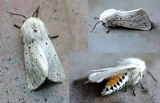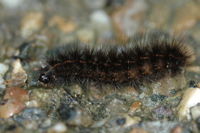
Spilosoma lubricipeda
Encyclopedia
The White Ermine is a moth
of the family Arctiidae
. It is found throughout the temperate belt of Eurasia
from Europe
through Kazakhstan
and Southern Siberia
to Amur
Region, China
, Korea
and Japan
. In China
several sibling species occur.

.jpg) The wingspan
The wingspan
is 34-48 mm. Wing pattern is very variable, from entirely white wings to strongly covered with black dots. Hindwings often with one or several black dots (rarely without any black dot). Antennae branches long (much longer than in similar Spilosoma urticae
), 3-5 times longer than the antenna stem diameter. The moth flies May to September depending on the location. They are not eaten by birds because they are poisonous.
The larvae feed on Stinging nettle
, Cytisus scoparius
, Alfalfa
, Echium vulgare and Taraxacum officinale
.
Moth
A moth is an insect closely related to the butterfly, both being of the order Lepidoptera. Moths form the majority of this order; there are thought to be 150,000 to 250,000 different species of moth , with thousands of species yet to be described...
of the family Arctiidae
Arctiidae
Arctiidae is a large and diverse family of moths with around 11,000 species found all over the world, including 6,000 neotropical species. This family includes the groups commonly known as tiger moths , which usually have bright colours, footmen , lichen moths and wasp moths...
. It is found throughout the temperate belt of Eurasia
Eurasia
Eurasia is a continent or supercontinent comprising the traditional continents of Europe and Asia ; covering about 52,990,000 km2 or about 10.6% of the Earth's surface located primarily in the eastern and northern hemispheres...
from Europe
Europe
Europe is, by convention, one of the world's seven continents. Comprising the westernmost peninsula of Eurasia, Europe is generally 'divided' from Asia to its east by the watershed divides of the Ural and Caucasus Mountains, the Ural River, the Caspian and Black Seas, and the waterways connecting...
through Kazakhstan
Kazakhstan
Kazakhstan , officially the Republic of Kazakhstan, is a transcontinental country in Central Asia and Eastern Europe. Ranked as the ninth largest country in the world, it is also the world's largest landlocked country; its territory of is greater than Western Europe...
and Southern Siberia
Siberia
Siberia is an extensive region constituting almost all of Northern Asia. Comprising the central and eastern portion of the Russian Federation, it was part of the Soviet Union from its beginning, as its predecessor states, the Tsardom of Russia and the Russian Empire, conquered it during the 16th...
to Amur
Amur
The Amur or Heilong Jiang is the world's tenth longest river, forming the border between the Russian Far East and Northeastern China .-Course:...
Region, China
China
Chinese civilization may refer to:* China for more general discussion of the country.* Chinese culture* Greater China, the transnational community of ethnic Chinese.* History of China* Sinosphere, the area historically affected by Chinese culture...
, Korea
Korea
Korea ) is an East Asian geographic region that is currently divided into two separate sovereign states — North Korea and South Korea. Located on the Korean Peninsula, Korea is bordered by the People's Republic of China to the northwest, Russia to the northeast, and is separated from Japan to the...
and Japan
Japan
Japan is an island nation in East Asia. Located in the Pacific Ocean, it lies to the east of the Sea of Japan, China, North Korea, South Korea and Russia, stretching from the Sea of Okhotsk in the north to the East China Sea and Taiwan in the south...
. In China
China
Chinese civilization may refer to:* China for more general discussion of the country.* Chinese culture* Greater China, the transnational community of ethnic Chinese.* History of China* Sinosphere, the area historically affected by Chinese culture...
several sibling species occur.

.jpg)
Wingspan
The wingspan of an airplane or a bird, is the distance from one wingtip to the other wingtip. For example, the Boeing 777 has a wingspan of about ; and a Wandering Albatross caught in 1965 had a wingspan of , the official record for a living bird.The term wingspan, more technically extent, is...
is 34-48 mm. Wing pattern is very variable, from entirely white wings to strongly covered with black dots. Hindwings often with one or several black dots (rarely without any black dot). Antennae branches long (much longer than in similar Spilosoma urticae
Spilosoma urticae
The Water Ermine is a moth of the family Arctiidae. It is found in temperate belt of the Palearctic ecozone like similar Spilosoma lubricipedum, but prefer more dry biotopes. So, S. urticae is more abundant in steppes and it is the single Spilosoma species in Central Asia.The wingspan is 38-46 mm....
), 3-5 times longer than the antenna stem diameter. The moth flies May to September depending on the location. They are not eaten by birds because they are poisonous.
The larvae feed on Stinging nettle
Stinging nettle
Stinging nettle or common nettle, Urtica dioica, is a herbaceous perennial flowering plant, native to Europe, Asia, northern Africa, and North America, and is the best-known member of the nettle genus Urtica...
, Cytisus scoparius
Cytisus scoparius
Cytisus scoparius, the Common Broom and Scotch Broom, syn. Sarothamnus scoparius, is a perennial leguminous shrub native to western and central Europe,....
, Alfalfa
Alfalfa
Alfalfa is a flowering plant in the pea family Fabaceae cultivated as an important forage crop in the US, Canada, Argentina, France, Australia, the Middle East, South Africa, and many other countries. It is known as lucerne in the UK, France, Australia, South Africa and New Zealand, and known as...
, Echium vulgare and Taraxacum officinale
Taraxacum officinale
Taraxacum officinale, the common dandelion , is a herbaceous perennial plant of the family Asteraceae . It can be found growing in temperate regions of the world, in lawns, on roadsides, on disturbed banks and shores of water ways, and other areas with moist soils. T...
.

